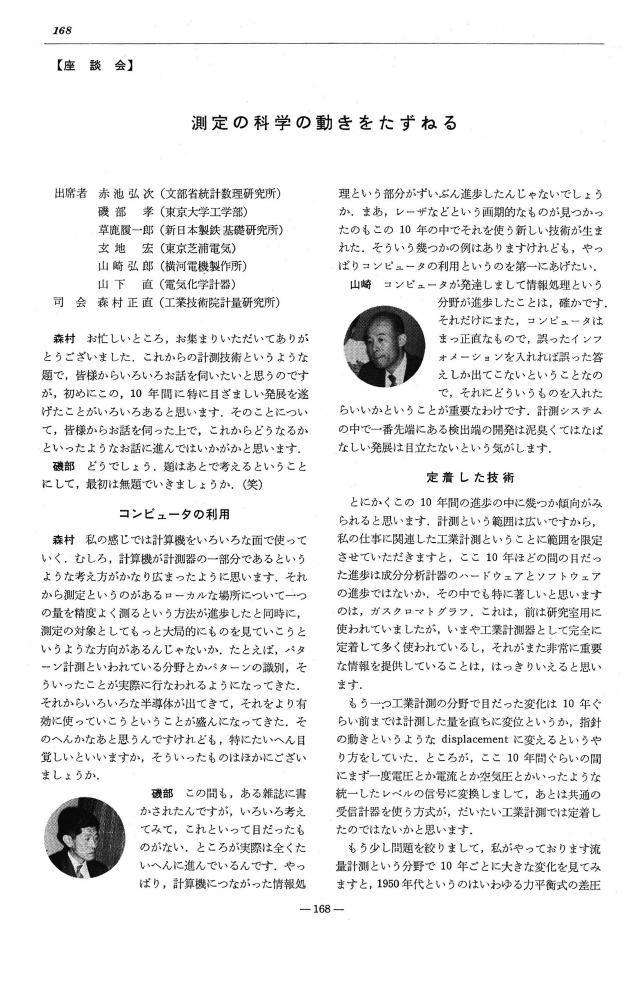1 0 0 0 株式会社横須賀さいか屋社史
- 出版者
- 横須賀さいか屋
- 巻号頁・発行日
- 1964
1 0 0 0 街娼記 : 蝕める肉体の挽歌
1 0 0 0 OA 安全な水素発生装置 : 防爆管の開発
- 著者
- 山浦 秀男 中村 次郎
- 出版者
- 公益社団法人 日本化学会
- 雑誌
- 化学と教育 (ISSN:03862151)
- 巻号頁・発行日
- vol.35, no.4, pp.368-369, 1987-08-20 (Released:2017-07-13)
1 0 0 0 岡山県商工名鑑
- 著者
- 岡山県商工名鑑編集委員会 編
- 出版者
- 岡山県商工会議所連合会
- 巻号頁・発行日
- vol.1964年版, 1964
1 0 0 0 岡山県商工名鑑
- 著者
- 岡山県商工名鑑編集委員会 編
- 出版者
- 岡山県商工会議所連合会
- 巻号頁・発行日
- vol.1960年版, 1960
1 0 0 0 OA 自立活動の授業過程における肢体不自由特別支援学校教師の困難さへの対処
- 著者
- 植田 佐知子 安藤 隆男
- 出版者
- 一般社団法人 日本特殊教育学会
- 雑誌
- 特殊教育学研究 (ISSN:03873374)
- 巻号頁・発行日
- vol.59, no.2, pp.73-82, 2021-08-31 (Released:2022-02-28)
- 参考文献数
- 24
本研究の目的は、肢体不自由特別支援学校の重複障害学級の教師を対象として、自立活動の授業過程における困難さに教師がどのように対処し、その結果としてどのような内容を獲得したのかを明らかにすることである。自立活動の授業過程に関する質問項目の因子分析の結果から、教師は困難さを自覚し、同僚との協働により対処していた。多変量分散分析を行った結果、肢体不自由教育経験年数の1~5年の教師群は困難さを抱きやすく、相談相手および相談機会を多くもつ教師群は困難さを同僚との協働により対処していた。困難さへの対処により教師が獲得した内容に関する自由記述を分析したところ、教師は自立活動の指導における「身体の動きの指導に関する知識・技術」「実態に応じた指導方法」「教師として求められる多様な視点」を獲得していた。また、肢体不自由教育経験年数により、教師の獲得内容は異なった。以上から、自立活動に関する教師の力量形成には、教師たちの協働化を促進する学校組織の形成や実践経験に応じた研修内容の見直しの必要性が示唆された。
1 0 0 0 OA アルミニウムイオン添加による難分解性ホウフッ化物イオンの分解とフッ化物イオンの処理
- 著者
- 山田 悦 清水 光 布施 泰朗
- 出版者
- 大学等環境安全協議会
- 雑誌
- 環境と安全 (ISSN:18844375)
- 巻号頁・発行日
- vol.5, no.3, pp.191-198, 2014-09-30 (Released:2014-10-10)
- 参考文献数
- 23
フッ化物イオンとホウフッ化物イオンの混合溶液の分析は、フッ化物イオン電極を用いたグランプロット標準添加法により、ホウフッ化物イオンの分解に用いるアルミニウムイオンの妨害を受けずにフッ化物イオンを定量することができ、その値からホウフッ化物イオンの分解率を求めることができた。難分解性であるホウフッ化物イオンは、常温においてアルカリ性や中性条件下ではほとんど分解せず、pH 3という酸性条件下でも2カ月後に20 %残存していたが、pH 3~4でアルミニウムイオンを添加すると約48時間で定量的に分解できることがわかった。アルミニウムイオンを添加するとフッ化アルミニウムを生成するためホウフッ化物イオンの分解が促進されると考えられる。 ホウフッ化物分解後のフッ化物イオンの処理は、カルシウム添加法とフッ素吸着樹脂を用いるカラム吸着法を組み合わせた二段階処理法を用いると、洗煙廃水のような複雑組成中のフッ化物イオンでも排水基準の 8 ppmをクリアして処理することができる。
1 0 0 0 OA 植物由来の香辛エッセンスを利用した人と環境に優しい新線虫防除技術の開発
本研究の目的は、農薬による線虫防除法の代替技術として、植物エッセンスによる線虫防除技術を確立することである。24年度は、ニッケイ、トウガラシ類(ジョロキア、黄金等)、25・26年度は木本類であるシキミ、アセビのエッセンスを水蒸気蒸留法、バーコレーション法、圧搾法、煮出し法,エタノール溶媒抽出法を用いて抽出した。また、試作した植物酢液抽出装置によりショウガ酢液、トウガラシ酢液、シキミ酢液、アセビ酢液の殺線虫効果を調査した。その結果、①ニッケイ、②トウガラシ、③ショウガ、④シキミ、⑤アセビのエッセンスには、強い殺線虫効果があることが明らかになった。
1 0 0 0 OA 係留船に対する安全対策について
- 著者
- 久保田 秀夫 平原 祐
- 出版者
- 公益社団法人 日本船舶海洋工学会
- 雑誌
- 日本造船学会誌 (ISSN:03861597)
- 巻号頁・発行日
- vol.715, pp.28-35, 1989-01-25 (Released:2018-04-05)
1 0 0 0 OA 測定の科学の動きをたずねる
- 著者
- 赤池 弘次 磯部 孝 草鹿 履一郎 玄地 宏 山崎 弘郎 山下 直 森村 正直
- 出版者
- 公益社団法人 計測自動制御学会
- 雑誌
- 計測と制御 (ISSN:04534662)
- 巻号頁・発行日
- vol.11, no.1, pp.168-182, 1972 (Released:2009-11-26)
1 0 0 0 OA 誤答効果と非回答バイアス ―投票率を例として―
- 著者
- 宮野 勝
- 出版者
- 数理社会学会
- 雑誌
- 理論と方法 (ISSN:09131442)
- 巻号頁・発行日
- vol.1, no.1, pp.101-114, 1986-11-20 (Released:2009-03-01)
- 参考文献数
- 27
- 被引用文献数
- 2
投票率を例として、標本調査が社会の実際と異なる理由を三分し、その相対的重要性を調べる方法を考察する。データとした1980年衆議院選挙に関する明るい選挙推進協会の全国3000サンプル調査の投票率は、選挙結果より12.4%高かった。第一に、この差を、(1)標本誤差、(2)「誤答効果」、(3)非回答バイアス、の三原因に数学的に分解できることを示した。第二に、層別二段抽出法による標本誤差の5%信頼区間はわれわれのデータでは±2.2%であることから、標本誤差以外の二原因によって10.2%~14.6%の誤差がもたらされていると推測した。そこで、第三に、点推定である12.4%を用いて、この誤差を「誤答効果」と非回答バイアスとに分解することを試みた。一つ目の方法は、非線形回帰分析を用いた統計的手法で、データが十分に存在する場合に適用できる。二つ目の方法は、先験的にまたは他のデータから仮定を導入して、数学的に解く手法である。われわれは二つ目の方法を用いて三種類の異なる仮定の各々について推定した。その結果、非回答バイアスが重要で、7~13%の差をもたらし、「誤答効果は」0~6%の差をもたらしたと推測された。第四に、性別などの属性別の分析が可能であり、投票率のデータでは、男性の方が誤差が大きく、非回答バイアスのウェイトも大きい。また、投票―棄権と回答―非回答とが正の相関を持ち、特に非投票者に非回答バイアスの影響が大きい。以上の検討は、標本調査データの特質の理解に重要であり、かつ、投票率以外の項目、例えば、投票政党、教育年数、所得、等にも適用可能である。
1 0 0 0 OA 戦時期植民地朝鮮における陸運統制の展開 : 国鉄輸送の計画化を中心として
- 著者
- 林 采成
- 出版者
- 土地制度史学会(現 政治経済学・経済史学会)
- 雑誌
- 土地制度史学 (ISSN:04933567)
- 巻号頁・発行日
- vol.43, no.2, pp.1-17, 2001-01-20 (Released:2017-12-30)
With the outbreak of the Sino-Japanese war, the Japanese colonial government in Korea attempted to use statecontrolled operation of the colonial economy to allocate its limited resources preferentially to the war effort and warrelated sectors. The land transportation sector, which had occupied only a secondary position in economic activity in peacetime, became a vital influence on the wartime economy. The Korean National Railways(KNR) had to adjust to wide gaps between supply and demand. This was done not only by reinforcing seasonal and geographical regulation of freight traffic, but also by allocating transportation capacity according to state-defined order of priority. General planning of transportation was promoted with the development of the controlled economy and the sudden increase in military transportation from 1941. An ex ante allocation system of transportation capacity through information exchange between KNR and its distribution control association was established. Simultaneously, state control was extended to the terminal sector of rail transportation and controlled mergers of forwarding agencies were promoted. After the outbreak of the Pacific War, the government emphasized relay land transportation of resources from China via the Korean Peninsula to make up for the decline in marine transportation capacity. The colonial government in Korea established a linked land and marine transportation system through an administrative reorganization that included merging the land and port forwarding agencies. Although transportation planning was extended to the China-ManchuriaKorea-Japan traffic stream, integration of the four railways for planning optimization was prevented by the Korean colonial government's objection to the separation of transportation and administration - an objection grounded in the view that planned transportation was indispensable to the operation of a planned economy. Thus, only a limited degree of unification was achieved in the management of relay transportation. There was a clear need for increased state intervention, given market conditions of excess demand and centralized planning of the economy. This greater state control was in fact achieved, but transportation still ended up becoming a bottleneck of the wartime economy, due to resource shortages and poor coordination between the different areas under Japanese control.
1 0 0 0 講談全集
- 著者
- 大日本雄弁会講談社 編
- 出版者
- 大日本雄弁会講談社
- 巻号頁・発行日
- vol.45, 1955
- 出版者
- 京都民科歴史部会
- 巻号頁・発行日
- no.211, 1993-07


